TEFILLIN are leather boxes, worn on the hand and arm (see Ch.4), that contain four passages from the Torah (25:5;32:1): “Sanctify to me…” (Ex.13:1-10); “When HA-SHEM brings you…” (Ex.13:11-16); “Hear, O Israel…” (Deut.6:4-9); and “If you observe My Commandments…” (Deut.11:13-21). On the importance of wearing TEFILLIN see 37:1 and 38:12.
The passages must be written in order, and it is preferable to write those in the arm phylactery first (32:1). Those in the head phylactery are written on four separate pieces of parchment (see 32:14); those in the arm phylactery, on one piece (32:2,47). The parchment must be made from the skin of a kosher type of animal or bird (32:12). It must be an undamaged piece (32:13) from the outer layer of the skin, and the writing must be on its inner surface; see 32:7. It must be tanned for that purpose, by a Jew; see 32:8-11. It is customary to write each passage in the arm phylactery on seven lines, and in the head phylactery on four (35:1). The lines should be straight, with rulings around the sides of the passages (see 32:6), and there must be spaces between letters, words, lines, and verses, as well as margins around the passages; see 32:28,32. The lines should be even (see 32:33-35); on the indentations at the beginnings and ends of the passages see 32:36.
The passages must be written with intent (32:19), with the right hand (see 32:5), in black ink (see 32:3), and the pen should be tested before writing (32:22). They must be written by a literate, religious adult male Jew (see 32:30;39:1), and only such a person may participate in making TEFILLIN (39:2). (On other classes of persons see 39:3-4; on trustworthiness about TEFILLIN see 39:5-9.) If the writer does not know the passages by heart, he must either copy them from a written text, or write them from dictation which he repeats word by word (32:29,31). They should be checked before writing each Divine Name and after completing each passage; see 32:21,22. The letters should be separated, well-formed, and not too thin (32:4). On the correct shapes of the letters see 32:16; 36:1-3. If a word is not spelled correctly, the passage is invalid (32:20). The letters must be written in order; if a letter was omitted, the passage is invalid and must not be corrected (32:33). On fixing letters that were improperly written or become damaged see 32:15-18,23-27. TEFILLIN that are in regular use do not, strictly speaking, require inspection (39:10).
The passages are inserted into black leather boxes, made from the skin of a kosher type of animal or bird and tanned for that purpose (32:37,40,48), and the same is true for the straps (33:3; see below). The arm phylactery box has one compartment, and the head phylactery box has four small equal compartments; both must be made from one piece of skin (32:38-39). Before insertion into the boxes, the passages are rolled up from their ends and tied with strips of parchment and with bullock’s hair (see 32:44); they are then inserted upright into their compartments (see 32:45-47). There are two views about the order of the passages in the head phylactery; see 34:1-4.
The boxes must be square, but need not be cubical; see 32:39,41. The head phylactery box must have grooves marking the compartments (32:40) and must have an embossed letter “shin” on each side (see 32:42-43). The boxes sit on square bases (32:39), with slightly narrower extensions on one side through which straps are passed (32:44,52). They are sewed together with the sinews of a kosher animal, preferably an ox; see 32:49-51. On what to do if the boxes or stitches are damaged see 33:1-2; on using parts of one phylactery for the other one see 42:1-2. The straps must be black on the outside and must not be red on the inside (33:3). The straps, and preferably the boxes, must be blackened by a Jew (33:4). On repairing damaged straps see 33:5. The width of the straps should be at least the length of a barleycorn (27:11). The strap of the head phylactery has a knot in the shape of the letter “dalet”, and that of the arm phylactery has a knot in the shape of the letter “yud” (see 32:52); on the locations of the knots see Ch.4.
Shulchan Aruch, Copyright (c) 2000 Project Genesis, Inc.


